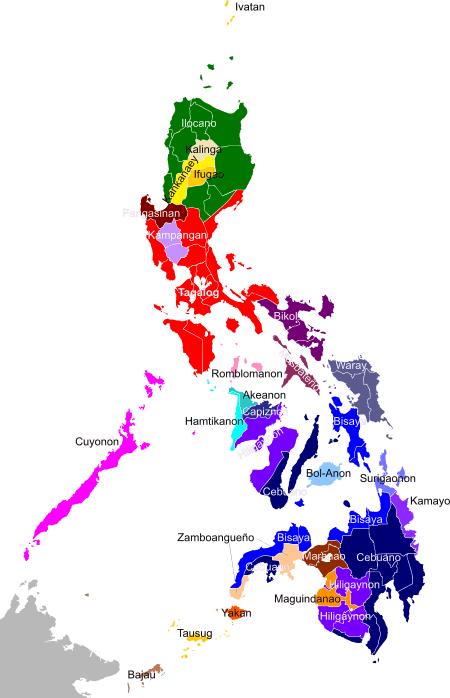Ilocandia

Ilocandia is the term given to the traditional homeland of the Ilocano people.
From the original western strip of Northern Luzon (now known as the Region 1 or Ilocos Region), Ilocandia has spread throughout the Cagayan Valley, Cordillera Administrative Region, and some parts of Central Luzon.
Although there are also a large number of Ilocanos in other parts of the Philippines like, Palawan and Mindanao, these are not considered to be a part of Ilocandia, as they are not part of the traditional Ilocano homeland.
Provinces of the Ilocandia
Today, the first three regions of the Philippines (Region 1 or Ilocos Region, Region 2 or Cagayan Valley and Region 3 or Central Luzon) comprise the present-day Ilocandia. Although most of the residents of the Cordillera Administrative Region belong to another ethnic group (the Igorots), the predominance of the usage of Ilocano makes it also a part of the Ilocandia.
Region 1 or the Ilocos Region
The northern portion of Ilocos Region (Ilocos Norte and Ilocos Sur) is the original Ilocano homeland. Originally composed of a single province known as Ilocos Province, it used to cover the western part of Northern Luzon. Today, the Ilocos Region includes four provinces, Pangasinan being the home of more than half of the region's population.
It is mistaken to assume that residents of Pangasinan are Ilocano speakers considering that according to the 2000 census, only 44% of Pangasinan population speak Ilocano. Pangasinan cannot even be considered as the original homeland of the Ilocano people since Ilocanos in Pangasinan are either migrants or descendants of migrants from the northern portion of Region 1 (Ilocos Norte and Ilocos Sur).
The northern portion of the country is known as the Nuclear Ilocandia since only 66% of Region 1 population are Ilocanos according to 2000 census. A substantial number of Region 1 population are Pangasinan, whose population accounts for 27% of the region's population. Other peoples also live in Region 1 such as the Bago, Agta and Ibaloi.
| Province | Capital | Population (2007) | Area (km²) | Pop. density (per km²) |
|---|---|---|---|---|
| Ilocos Norte | Laoag City | 547,284 | 3,399.3 | 151.3 |
| Ilocos Sur | Vigan City | 632,255 | 2,579.6 | 230.3 |
| La Union | San Fernando City | 720,972 | 1,493.1 | 440.7 |
| Pangasinan | Lingayen | 2,645,395 | 5,368.2 | 453.4 |
| Dagupan City [1] | — | 149,554 | 37.23 | 3,427 |
Component Cities of Region 1
Region 2 or Cagayan Valley
When the arid lands of the Ilocos Region could no longer support the growing number of Ilocanos, they tried the less chartered Cagayan Valley, which they later on find more suitable to their agricultural way of life. Although not originally a part of the Ilocandia, the Ilocanos have conquered the area, thus making it a part of the Greater Ilocandia.
The table below lists only the provinces where Ilocano is spoken as a lingua franca:
| Province/City | Capital | Population (2000) | Area (km²) | Pop. density (per km²) |
|---|---|---|---|---|
| Cagayan | Tuguegarao City | 993,580 | 9,002.0 | 110.4 |
| Isabela | Ilagan | 1,177,044 | 10,409.6 | 113 |
| Nueva Vizcaya | Bayombong | 366,962 | 3,903.9 | 94.0 |
| Quirino | Cabarroguis | 148,575 | 3,057.2 | 48.6 |
| Santiago City [2] | — | 110,531 | 255 | 433 |
Component Cities of Region 2
Region 3 or Central Luzon
Though a predominantly Kapampangan-speaking and Pangasinense-speaking region, Central Luzon acts as fringe-area of Ilocandia. Today, no province in the region is a predominantly Ilocano-speaking area, but some northern Municipalities use it as a lingua franca, especially in northernmost Tarlac and northwestern Nueva Ecija, with the southern parts around Bulacan leaning more towards Tagalog.
The table below shows only the provinces that have a significant number of Ilocano speakers:
| Province/City | Capital | Population (2000) | Area (km²) | Pop. density (per km²) |
|---|---|---|---|---|
| Nueva Ecija | Palayan City | 1,659,883 | 5,284.3 | 314.1 |
| Tarlac | Tarlac City | 1,068,783 | 3,053.4 | 350.0 |
| Zambales | Iba | 433,538 | 3,714.4 | 116.7 |
| Aurora | Baler | 173,797 | 3,147.3 | 68.0 |
Cities
The Central Luzon Region has only one city where Ilocano is the main language.
CAR or the Cordillera Administrative Region
Technically, the peoples of the Cordillera Administrative Region belong to another ethno-linguistic group collectively known as the Igorots. Hence, they are not a part of the Original Ilocandia nor the Greater Ilocandia. However, because of the presence of the different ethno-linguistic groups, Ilocano has become the medium of communication between these different tribes.
| Province/City | Capital | Population (2007)[3] | Area (km²) | Pop. density (per km²) | |
|---|---|---|---|---|---|
| Abra | Bangued | 230,953 | 3,975.6 | 58.1 | |
| Apayao | Kabugao | 103,633 | 3,927.9 | 26.4 | |
| Benguet | La Trinidad | 372,533 | 2,599.4 | 143.3 | |
| Ifugao | Lagawe | 180,711 | 2,517.8 | 71.8 | |
| Kalinga | Tabuk | 182,326 | 3,119.7 | 58.4 | |
| Mountain Province | Bontoc | 148,661 | 2,097.3 | 70.9 | |
| Baguio City [4] | — | 301,926 | 57.5 | 5,250.9 | |
Component Cities of CAR
See also
References
- ↑ Dagupan City is an independent component city, figures are excluded from Pangasinan province.
- ↑ Santiago City is an independent component city, figures are excluded from Isabela province.
- ↑ Final results - 2007 Census of Population Archived July 16, 2012, at the Wayback Machine.
- ↑ Baguio City is a highly urbanized city; figures are excluded from Benguet Province.